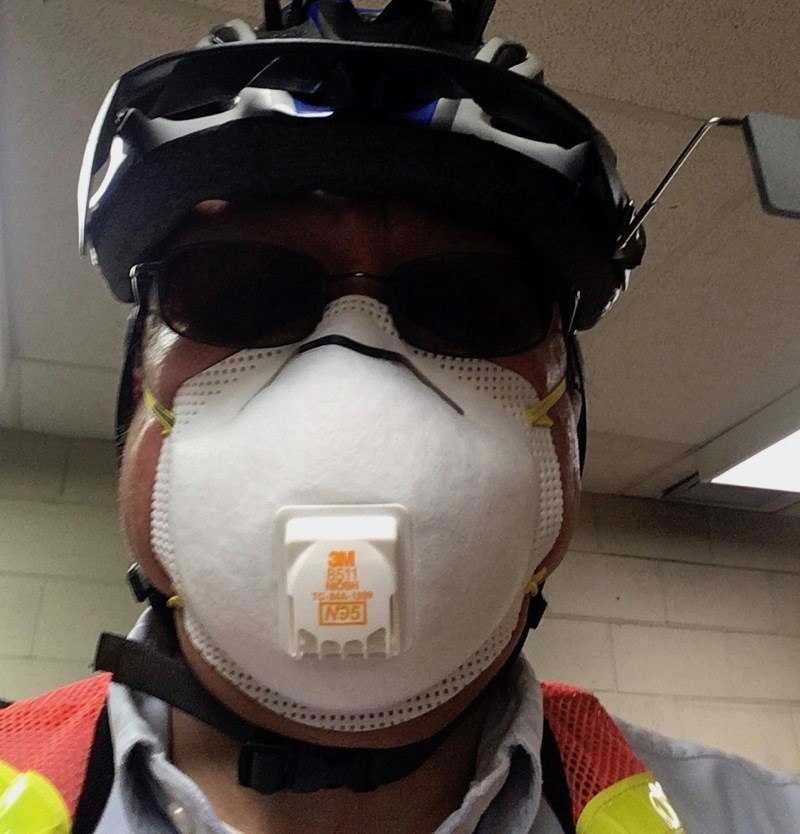You need to wear the right type of mask, and to wear it properly, to ward off wildfire smoke. That’s the message from the experts. Here’s a summary of their advice.
If you’re going to wear a mask, look for ones that are labelled NIOSH N95 or P100. The N95s are readily available at hardware stores and pharmacies (except when there’s a run on them during wildfire season) for around $3 to $5 each; they’re cheaper in bulk. For a P100, you’ll face more of a hunt, higher cost, and more steps to assemble and put it on.
Basic dust masks and surgical masks are not useful in warding off wildfire particulates. Bandanas or scarves aren’t helpful either.
If you have a health condition, especially one involving your lungs or heart, consult your doctor before wearing a mask.
You’re putting on a mask to protect your breathing. But wearing a mask makes it harder to breathe because there’s a barrier blocking the in-flow of air. If you already have trouble with breathing, a mask might not be a good idea. Stay indoors instead. Try to find a place that’s running an air cleaner with a HEPA filter. Avoid physical activity that requires heavy breathing.
Putting on a mask properly is essential, otherwise wildfire particulates will leak in. A typical N95 will have a flexible metal strip at the top to fit the mask tightly to the nose, and it will curve under the chin. It has two straps to pull the mask tight to the face. The top strap goes above the ears, the bottom strap goes below.
Facial hair will impede the usefulness of a mask. Children’s sizes do not appear to be available.
Switch to a fresh mask regularly. Don’t keep using the same one for days on end. There’s no indicator to show when an N95 mask has lost its effectiveness. There’ll be a bit of guesswork — when it gets harder to breathe when wearing it, or when it gets grimy.
Around Greater Victoria in the past week, I’ve noticed quite a few people wearing masks, and many of them appeared to have an N95. But there were also plenty of people wearing masks and bandanas that the experts have deemed to be ineffective. I saw no one with a P100.
I’ve found that it’s much more comfortable to wear an N95 that has a valve — the ones with a square of plastic on the outside of the mask. The valve helps to expel what you breathe out, reducing heat and humidity inside the mask.
Since a bout of pneumonia 20 years ago, I’ve found that polluted air can make me uncomfortable. One symptom is coughing. During the peak of the wildfire smoke in Greater Victoria this past week, I wore an N95 while bicycling. I’ve worn N95s before for projects around the house, like sanding in preparation for painting. I initially bought ones without the valve, which are cheaper. They were uncomfortable and I could not wear them for long. With the valve models, wearing one for an hour or more is no big deal.
I’ve also discovered that it’s not a good idea to eat something, especially something smelly, before putting on an N95. The food smell will impregnate the mask and you’ll be constantly reminded of what you ate.
Sources:
Dr. Sarah Henderson, senior scientist at the B.C. Centre for Disease Control, says in a video posted on YouTube that N95 masks can be helpful if they are properly fitted. But surgical masks are of no help. People working outdoors in wildfire smoke should consider wearing a mask. “For the general public, however, we really recommend that you simply seek a cleaner air environment, because those masks make it harder to breathe if you’re already having breathing difficulty to begin with.”
https://www.youtube.com/watch?v=yA3XM4p3Q7U&feature=youtu.be
Interior Health has issued a bulletin about mask use. Because of the limitations of masks, it's better to try to stay indoors, it says. "The best way to protect the health of yourself and your family during smoky sky events is to seek cleaner air. You can buy a HEPA air cleaner for a room in your home, you can go to a building with a good air filtration system, or you can leave the area. If this is not practical, it may help to simply stay indoors and reduce your physical activity."
https://www.interiorhealth.ca/YourEnvironment/EmergencyPreparedness/Documents/Using%20Face%20Masks%20During%20Wildfire%20Smoke%20Events.pdf
An FAQ on wildfire smoke from WorkSafe B.C. makes a distinction between “masks,” which are not designed to filter out particulates, and “respirators” such as the N95, which do filter. It emphasizes the need for proper fit.
https://www2.gov.bc.ca/assets/gov/public-safety-and-emergency-services/wildfire-status/current-wildfire-situation/wildfire-smoke-faq-pdf-en.pdf
Instruction booklets in PDF form from WorkSafe B.C. on how to select and fit a respirator.
https://www.worksafebc.com/en/health-safety/tools-machinery-equipment/personal-protective-equipment-ppe/types/respiratory-protection
An instruction sheet from the Washington State Department of Health says masks such as the N95 and P100 — or respirators to be more precise — provide some protection for your lungs from particulates, but they do not protect you from hazardous gases such as carbon monoxide and formaldehyde.
https://www.doh.wa.gov/Portals/1/Documents/Pubs/334-353.pdf
The AirNow website, hosted by the U.S. Environmental Protection Agency, emphasizes that dust and surgical masks do not provide protection from wildfire smoke.
https://www.airnow.gov/index.cfm?action=smoke.index
An EPA document on selecting the right respirator and putting it on correctly.
https://www3.epa.gov/airnow/smoke_fires/respiratory-protection-508.pdf
An overview of the wildfires in B.C.
2018 B.C. wildfires: Interactive map, air quality, smoke advisories
And, some reflecting on how to spell dos and don’ts
https://www.quickanddirtytips.com/education/grammar/dos-and-donts




